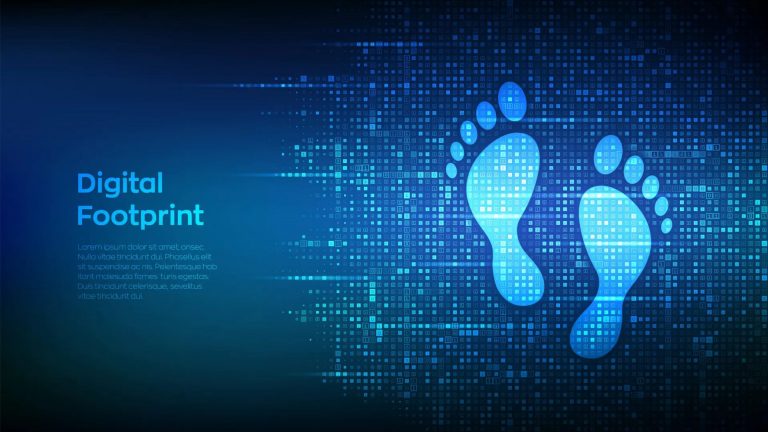
When you walk on the beachfront, you leave something behind. Your footprint. Well, it’s the same for the online space. Every online interaction—be it a casual post on social media, a search query, or a transaction on an e-commerce site—contributes to what is known as a digital footprint. Now, your digital footprint refers to the trail of data that individuals leave behind as they navigate the internet. Although these interactions may seem harmless, the cumulative effect can create a permanent and often inescapable record of one’s online life, raising significant concerns about personal privacy and security.
What makes up a Digital Footprint?
Digital footprints include both active and passive footprints.
Active Footprints are the traces left intentionally by users. For instance, posting photos, writing blog entries, and sharing updates on social media are all deliberate actions that contribute to one’s digital persona. Each piece of content shared reflects personal beliefs, preferences, and social circles.
Register for Tekedia Mini-MBA edition 19 (Feb 9 – May 2, 2026): big discounts for early bird.
Tekedia AI in Business Masterclass opens registrations.
Join Tekedia Capital Syndicate and co-invest in great global startups.
Register for Tekedia AI Lab: From Technical Design to Deployment (next edition begins Jan 24 2026).
Passive Footprints are the direct opposite. They are generated without conscious user intent. They include data collected through website cookies, tracking pixels, and analytics tools that monitor user behavior across various platforms. Even simple actions like browsing a webpage or clicking a link can contribute to this passive footprint, often without the user’s awareness.
How does this build up into a digital footprint?
As we engage with digital platforms, a wealth of information is accumulated over time. Companies use algorithms to analyze this data, creating detailed profiles that predict our preferences and behaviors. This data can include anything from our browsing history and purchase patterns to our social media interactions and location data. The implications of this accumulation are profound.
While many users may enjoy personalized content and targeted advertising, they often overlook the risks associated with having such extensive data profiles. As we discussed previously, companies might share this information with third parties or face data breaches, exposing sensitive information to malicious actors.
The permanence of digital footprints poses significant long-term implications for personal privacy so you might need to exercise caution. Here are several critical aspects to consider:
1. Irreversibility: Once information is shared online, it can be challenging to remove it entirely. Even if you delete a post or account, it may still exist in the form of screenshots, cached pages, or data stored by third parties. This irreversibility can haunt individuals, particularly in the case of controversial or embarrassing content.
2. Reputation Management: Digital footprints can impact personal and professional reputations. Employers increasingly conduct online searches to vet potential candidates, and a negative or unprofessional digital footprint can lead to missed job opportunities. Similarly, personal relationships can be strained by the kind of information available online.
3. Targeted Surveillance and Marketing: The detailed profiles created from digital footprints enable not only targeted advertising but also surveillance by corporations and governments. This raises concerns about user autonomy and consent, as individuals may not be fully aware of how their data is being used.
4. Legal Implications: As regulations surrounding data privacy evolve, individuals may find themselves affected by laws that can trace back to their digital footprints. This can include accountability for harmful content shared online or the potential for legal action stemming from privacy violations. Even a post you made years back, can haunt you if they can connect them to certain harmful events.
5. Identity Theft and Fraud: With so much personal information readily available, individuals are more susceptible to identity theft and fraud. Cybercriminals can exploit digital footprints to gain access to sensitive data, leading to financial loss and long-term damage to one’s credit and identity.
Understanding this is not meant to scare you from using the internet freely. It is just meant to let you know that no one is anonymous online, and actions do have consequences. So, your post or comment made for ‘cruise’ purposes can haunt you much later. Take control of your online presence and manage the details that consciously or unconsciously become a part of your digital footprint.
The previous article on online safety talked about updating your privacy settings when surfing the internet, but that can also apply to social media accounts. You may consider using tools like VPNs, ad blockers, and privacy-focused search engines to help safeguard your online activity. Also, try to do occasional audits of your online image. Search for your name and review what information is publicly available. This can help you identify any content that may need to be edited, removed, or countered.
Most importantly, think before you post. A little mindfulness in your online activities wouldn’t hurt. Mind your language when you post or comment online. Some people have made disrespectful comments to people who could be their potential employers, partners, or investors. Consider the potential long-term implications of your digital content. Using online platforms is not just about having fun. There are implications. Every click, post, and search contributes to a digital footprint that can have lasting effects on personal privacy. While the internet offers countless opportunities for connection and expression, it also comes with responsibilities.



